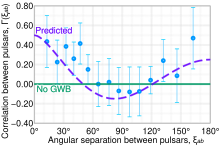Hellings-Downs curve

The Hellings-Downs curve (also known as the Hellings and Downs curve) is an analytical tool that helps to find patterns in pulsar timing data in an effort to detect long wavelength gravitational waves.[2][3][4] More precisely, the Hellings-Downs curve refers to the wave-like shape predicted to appear in a plot of timing residual correlations versus the angle of separation between pairs of pulsars.[5][6] This theoretical correlation function assumes a gravitational wave background that is isotropic and Einsteinian.[7][8]
Pulsar timing array residuals[edit]

Albert Einstein's theory of general relativity predicts that a mass will deform spacetime causing gravitational waves to emanate outward from the source.[10] These gravitational waves will affect the travel time of any light that interacts with them. A pulsar timing residual is the difference between the expected time of arrival and the observed time of arrival of light from pulsars.[2] Because pulsars flash with such a consistent rhythm, it is hypothesised that if a gravitational wave is present, a pattern may be observed in the changing arrival times of these pulsar emissions. The Hellings-Downs curve is used to infer the presence gravitational waves by finding patterns in the pulsar residual data. Pulsar timing residuals are measured using pulsar timing arrays.[11]
History[edit]
Not long after the first suggestions of pulsars being used for gravitational wave detection in the late 1970’s,[12][13] Donald Backer discovered the first millisecond pulsar in 1982.[14] The following year Ron Hellings and George Downs published the foundations of the Hellings-Downs curve in their 1983 paper "Upper Limits on the Isotropic Gravitational Radiation Background from Pulsar Timing Analysis"[7]. Donald Backer would later go on to become one of the founders of the North American Nanohertz Observatory for Gravitational Waves (NANOGrav).[1][14]
Examples in the scientific literature[edit]
In 2023, NANOGrav used pulsar timing array data collected over 15 years in their latest publications supporting the existence of a gravitational wave background.[1] A total of 2,211 millisecond pulsar pair combinations (67 individual pulsars) were used by the NANOGrav team to construct their Hellings-Downs plot comparison.[15] The NANOGrav team wrote that "The observation of Hellings–Downs correlations points to the gravitational-wave origin of this signal."[4] This highlights the role that the Hellings-Downs curve plays in contemporary gravitational wave research.
Equation of the Hellings-Downs curve[edit]
Reardon et al. (2023) from the Parkes pulsar timing array team give the following equation for the Hellings-Downs curve:[16]
Where:
,
is the kronecker delta function
represents the angle of separation between the two pulsars as seen from earth
is the angular correlation function.
This curve assumes an isotropic gravitational wave background from a supermassive black hole binary system.
References[edit]
- ^ a b c "Evidence for a Gravitational-Wave Background | NANOGrav". nanograv.org. Retrieved 2024-02-18.
- ^ a b Romano, Joseph D.; Allen, Bruce (2024-01-29), Answers to frequently asked questions about the pulsar timing array Hellings and Downs curve, arXiv:2308.05847
- ^ Jenet, Fredrick A.; Romano, Joseph D. (2015-07-01). "Understanding the gravitational-wave Hellings and Downs curve for pulsar timing arrays in terms of sound and electromagnetic waves". American Journal of Physics. 83 (7): 635–645. arXiv:1412.1142. Bibcode:2015AmJPh..83..635J. doi:10.1119/1.4916358. ISSN 0002-9505. S2CID 116950137.
- ^ a b Agazie, Gabriella; Anumarlapudi, Akash; Archibald, Anne M.; Arzoumanian, Zaven; Baker, Paul T.; Bécsy, Bence; Blecha, Laura; Brazier, Adam; Brook, Paul R.; Burke-Spolaor, Sarah; Burnette, Rand; Case, Robin; Charisi, Maria; Chatterjee, Shami; Chatziioannou, Katerina (2023-07-01). "The NANOGrav 15 yr Data Set: Evidence for a Gravitational-wave Background". The Astrophysical Journal Letters. 951 (1): L8. arXiv:2306.16213. Bibcode:2023ApJ...951L...8A. doi:10.3847/2041-8213/acdac6. ISSN 2041-8205.
- ^ Allen, Bruce (2023-02-15). "Variance of the Hellings-Downs correlation". Physical Review D. 107 (4): 043018. arXiv:2205.05637. Bibcode:2023PhRvD.107d3018A. doi:10.1103/PhysRevD.107.043018. ISSN 2470-0010.
- ^ Allen, Bruce; Romano, Joseph D. (2023-08-24). "Hellings and Downs correlation of an arbitrary set of pulsars". Physical Review D. 108 (4): 043026. arXiv:2208.07230. Bibcode:2023PhRvD.108d3026A. doi:10.1103/PhysRevD.108.043026.
- ^ a b Hellings, R. W.; Downs, G. S. (1983-02-01). "Upper limits on the isotropic gravitational radiation background from pulsar timing analysis". The Astrophysical Journal. 265: L39. Bibcode:1983ApJ...265L..39H. doi:10.1086/183954. ISSN 0004-637X.
- ^ Chiara Mingarelli: Pulsar Timing Arrays, retrieved 2024-02-18
- ^ Reardon, Daniel J.; Zic, Andrew; Shannon, Ryan M.; Di Marco, Valentina; Hobbs, George B.; Kapur, Agastya; Lower, Marcus E.; Mandow, Rami; Middleton, Hannah; Miles, Matthew T.; Rogers, Axl F.; Askew, Jacob; Bailes, Matthew; Bhat, N. D. Ramesh; Cameron, Andrew (2023-07-01). "The Gravitational-wave Background Null Hypothesis: Characterizing Noise in Millisecond Pulsar Arrival Times with the Parkes Pulsar Timing Array". The Astrophysical Journal Letters. 951 (1): L7. arXiv:2306.16229. Bibcode:2023ApJ...951L...7R. doi:10.3847/2041-8213/acdd03. ISSN 2041-8205.
- ^ "GP-B — Einstein's Spacetime". einstein.stanford.edu. Retrieved 2024-02-18.
- ^ "Pulsar Timing Arrays". www.aei.mpg.de. Retrieved 2024-02-18.
- ^ Sazhin, M. V. (1978-02-01). "Opportunities for detecting ultralong gravitational waves". Soviet Astronomy. 22: 36–38. Bibcode:1978SvA....22...36S.
- ^ Detweiler, S. (1979-12-01). "Pulsar timing measurements and the search for gravitational waves". The Astrophysical Journal. 234: 1100–1104. Bibcode:1979ApJ...234.1100D. doi:10.1086/157593. ISSN 0004-637X.
- ^ a b "After 15 years, pulsar timing yields evidence of cosmic gravitational wave background". Berkeley. 2022. Retrieved 2024-02-18.
- ^ "The fingerprint of a cosmos swirling with gravitational waves". Physics Today. Retrieved 2024-02-18.
- ^ Reardon, Daniel J.; Zic, Andrew; Shannon, Ryan M.; Hobbs, George B.; Bailes, Matthew; Di Marco, Valentina; Kapur, Agastya; Rogers, Axl F.; Thrane, Eric; Askew, Jacob; Bhat, N. D. Ramesh; Cameron, Andrew; Curyło, Małgorzata; Coles, William A.; Dai, Shi (2023-07-01). "Search for an Isotropic Gravitational-wave Background with the Parkes Pulsar Timing Array". The Astrophysical Journal Letters. 951 (1): L6. arXiv:2306.16215. Bibcode:2023ApJ...951L...6R. doi:10.3847/2041-8213/acdd02. ISSN 2041-8205.






